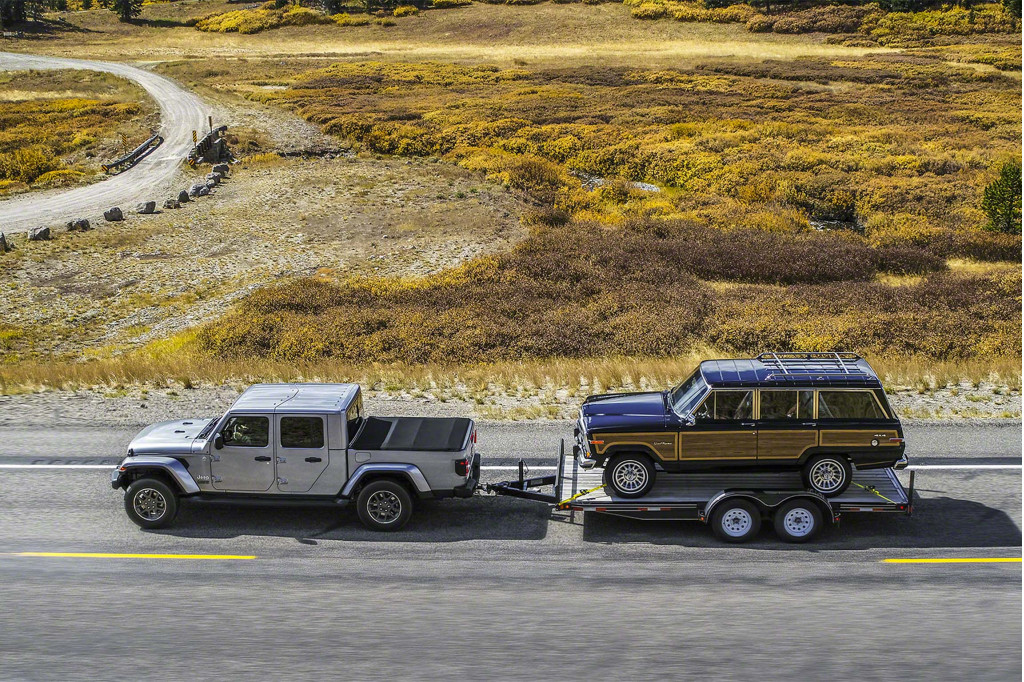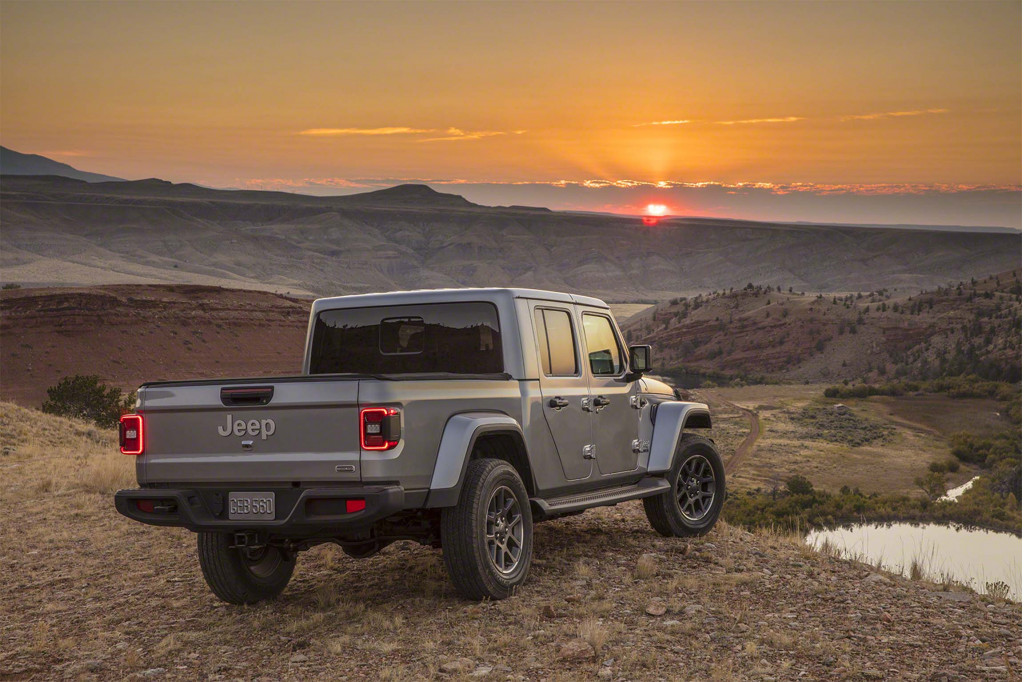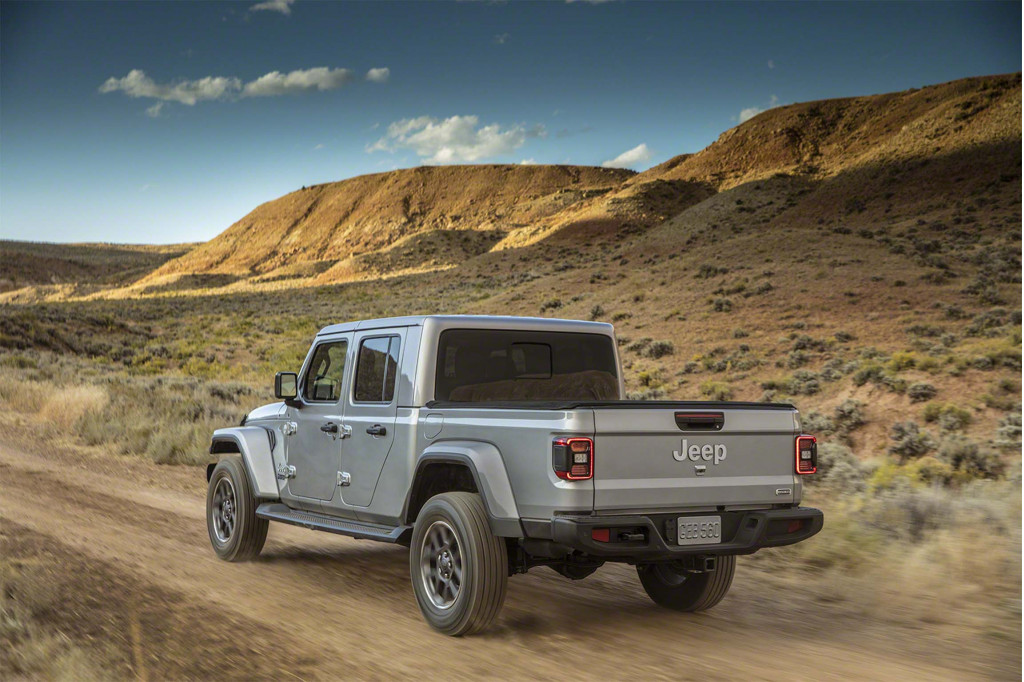A 5-foot pickup bed bolted behind the rear seat should clue even the least-keen observers that the 2020 Jeep Gladiator is not a Wrangler.
As Motor Authority learned during a day with the 2020 Gladiator on muddy, rocky roads at the base of the Sierra Nevadas in California, Jeep’s first pickup truck in a quarter century has less in common with the evergreen Wrangler than its seven-slot grille and big fender flares suggest.
DON’T MISS: First drive review: 2020 Jeep Gladiator
Here’s a look at what makes the Gladiator its own breed of Jeep and not just a Wrangler with open-air storage.

2020 Jeep Gladiator
1. More wheelbase, more space
The Gladiator uses a version of the Wrangler’s ladder frame that has been stretched more than two feet. In fact, the Gladiator is about 26 inches longer than the Wrangler. About 19 of those inches come between the wheels, with 3 inches earmarked to improve rear-seat leg room.
Accordingly, the Gladiator’s breakover and departure angles suffer. In Rubicon guise, however, the 20.3-degree breakover and 26-degree departure angles are nothing to scoff at for a truck that stretches 218 segment-stretching inches from bumper to bumper. By comparison, a Chevrolet Colorado is 224.9 inches long, but that’s for a Crew Cab with a 6-foot-2-inch bed.

2020 Jeep Gladiator
2. Here’s the beef
In a certain configuration—Sport trim with the optional 8-speed automatic transmission and towing package—the Gladiator is rated to tow 7,650 pounds. That’s 4,150 pounds more than the most capable Wrangler and puts it within 50 pounds of the diesel version of the Colorado, which leads the class.
To get there, Jeep specified robust Dana 44 front and rear axles for every Gladiator instead of the Dana 30 front and Dana 35 rear axles that come on Wrangler Sport and Sahara trims (the Wrangler Rubicon has Dana 44s). Additionally, the front axle walls are 10 mm thicker on the Gladiator than they are on the Wrangler.
Additionally, Gladiators have heavier wheels that sit in front of larger front brakes than Wranglers, although the two Jeeps share a bolt pattern and backspacing.

2020 Jeep Gladiator
3. Thanks, Ram
At first glance, the 2020 Gladiator’s coil-sprung suspension looks a lot like the Wrangler’s. However, Jeep dug into sister brand Ram’s proverbial parts bin for the rear suspension. The Ram 1500 donated its upper and lower control arms as well as its track bar to the Gladiator.
The two don’t share suspension mounting points, springs, or shock absorbers, however.
Gladiator Sport and Overland trims ride on conventional monotube shocks while the Rubicon makes use of long-travel Fox monotube shocks.

2020 Jeep Gladiator
4. What’s up front
At first glance—and even second, third, and fourth glances—the Gladiator is indistinguishable from the Wrangler up front.
However, the openings between its grille slats are slightly wider to allow for improved engine cooling since Jeep figures Gladiator owners are more likely to hitch up a trailer and lug it up a mountain.

2020 Jeep Gladiator
5. And what’s out back
Of course, what makes the Gladiator immediately different from the Wrangler is its bed. Just one bed length—5-feet—is available. It’s made of steel with an aluminum tailgate that features a dampening spring so it doesn’t slam open and can be closed with one hand.
The aluminum tailgate looks simple enough, but it has some tricks. Its wire straps can be tucked behind the rubber bump stops to keep it open just enough to allow owners to stack 4-by-8-foot sheets of plywood stacked on the wheel wells and let them hang out the back. Also, because the Gladiator’s top comes off, Jeep mounted the federally mandated third brake light near the tailgate’s handle.
Don’t look for a tailgate-mounted spare tire, either. It sits underneath, Jeep widened the frame rails aft of the rear axle to let a big 35-inch tire fit back there.

2020 Jeep Gladiator
6. Rear-seat riders
The Gladiator shares its doors with the four-door Wrangler, which means both Jeeps have narrow rear door openings for access to the rear seat. The Gladiator’s narrow door is misleading, however, since its longer wheelbase means that rear-seat riders have an extra three inches of leg room compared to the Wrangler.
That’s not all. The rear seat base is hinged and rotates upward to reveal two storage bins that can be optionally covered and locked. Behind the rear seat back, an optional Alpine-branded Bluetooth speaker lives in a charging dock and is ready to provide entertainment when tailgating or lounging at the beach.

2020 Jeep Gladiator
7. Sahara vs. Overland
The Gladiator lineup mostly mirrors the Wrangler’s, with one exception. Instead of christening the toniest version with the Sahara name that Jeep has used on the Wrangler since the early 1990s, the Gladiator borrows the Overland trim from the automaker’s Cherokee and Grand Cherokee lineups.
For now, it’s just a name. The Gladiator Sahara is swankier than the base Gladiator Sport, but not by much. Don’t look for the Cherokee SUVs’ fancy leather-wrapped dashboards and open-pore wood trim panels in the Gladiator Overland. Instead, it includes power features, automatic climate control, and 18-inch alloy wheels.